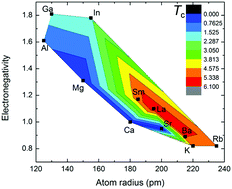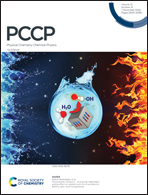Structures, electronic properties, and superconductivities of alkaline-earth metal-doped phenanthrene and charge transfer characteristics of metal-doped phenanthrene†
Abstract
To find potential alkaline-earth metal-doped aromatic superconductors and clarify the origin of superconductivity in metal-doped phenanthrene (PHN) systems, we have systematically investigated the crystal and electronic structures of bivalent metal (Mg, Ca, Sr and Ba)-doped PHNs by first-principles calculations. The results show that only Ba1.5PHN can satisfy the conditions of both thermodynamic stability and metallization. We predicted that Ba1.5PHN is superconducting with the critical temperature of 5.3 K. Based on the metal atomic radius and electronegativity and combined with monovalent metal- and trivalent metal-doped PHNs, the relations among charge transfer, metallization, and superconductivity were analyzed. The results indicate that the electronegativity of the metal element rather than the atomic radius is predominant in the charge transfer and superconductivity of metal-doped phenanthrene.



 Please wait while we load your content...
Please wait while we load your content...